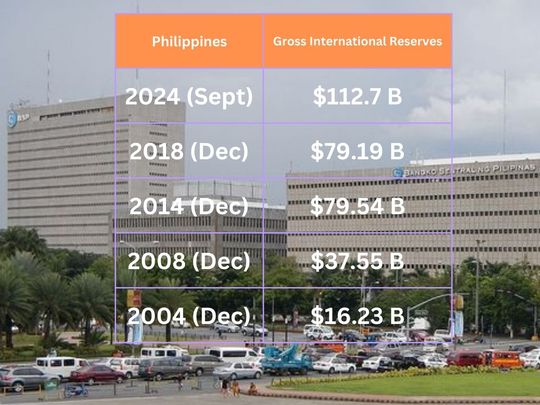
Manila: The Philippines has seens it gross international reserves (GIR) jump to $112.7 billion in September 2004, an 8.6 per cent increase from December 2023, and 42 per cent from 2014.
And in a remarkable shift, the Philippines's balance of payments (BOP) has hit a surplus of $3.5 billion in September 2024 — a dramatic turnaround from the $414 million deficit of September 2023.
This surplus, reported this month by the Bangko Sentral ng Pilipinas (BSP), marks a huge leap forward, fuelled by steady foreign deposits and gains from the BSP’s overseas investments.
Rise in reserves
The rise in the Philippines's GIR to $112.7 billion by end-September from $107.9 billion in August tells a story of resilience.
This reserve level offers a powerful liquidity buffer – capable of covering 8.1 months’ worth of imports and nearly 4.5 times the nation’s short-term debt — a strong cushion against potential external economic "shocks".
The Philippines (with $112.7 billion) ranked 28th in terms of GIR among countries, a notch lower than Canada ($116 billion), but ahead of Spain ($94.3billion), Vietnam ($93.3 billion), Belgium ($82 billion), and Denmark ($80 billion).
The Philippines’ September surplus also boosted the year-to-date BOP position to an impressive $5.1 billion, far exceeding the $1.7 billion from the same period in 2023.
Trade deficit narrows
Preliminary data points to a narrowing trade deficit and steady net inflows from personal remittances, trade services, and foreign borrowings by the national government.

For the first seven months of 2024 (January to July), personal remittances went up by 3 per cent from $20.91 billion in 2023 year to $21.53 billion this year. The BSP noted an expansion in cash remittances due to the growth in receipts from land- and sea-based overseas Filipino workers.
FDI
Foreign direct and portfolio investments (FDI) have also bolstered the BOP, painting a picture of a Philippine economy regaining stability and independence on the global financial stage.
From January to June 2024, foreign direct investment (FDI) approvals in the Philippines hit significant growth, totaling 950 billion pesos (around $16.7 billion), with 286 billion pesos (approximately $5 billion) attributed to foreign investments.
$ 73.5 b
value of projects granted “green lane” certificates in the Philippines as of October 2024Notable investments were made in the following sectors: manufacturing, renewable energy, finance and insurance. As of October, the Philippine Board of Investments (BOI) granted “green lane” certifications to 126 projects, accelerating $73.5 billion (4.13 trillion pesos) in investments.
The Philippines also topped its Asean neighbours in 2023 FDI rankings, according to the DTI.
This turnaround could very well symbolise a new chapter for the Philippines, demonstrating a robust stance against external vulnerabilities and bolstering confidence in its economic footing.
Here’s what each element represents:
Higher GIR:
GIR represents the country’s stock of foreign currency, gold, special drawing rights (SDRs), and reserve positions in international organisations.
When reserves increase, it often suggests that the country has a strong buffer to manage currency fluctuations, meet international financial obligations, and protect against economic shocks.
These are the some of the upsides of higher GIR:
Import cover:
A high level of GIR means the country can fund imports for several months without running out of foreign currency, which supports trade and economic stability.
Debt security:
Sufficient reserves help assure creditors of the country’s capacity to service its foreign debt, thereby reducing the risk of default.
Investor confidence:
Higher reserves can boost investor confidence, signaling that the country has enough liquidity to handle external uncertainties, or “shocks”.
Positive balance of payments (BOP) position:
The BOP measures all economic transactions between a country and the rest of the world, including trade, investment, and financial transfers. A positive BOP indicates that inflows (such as export earnings, foreign investments, and remittances) exceed outflows (like imports and debt repayments).
These could imply the following:
Trade competitiveness:
If the BOP surplus is driven by exports, it suggests strong global demand for the country’s goods or services, often leading to job growth and higher GDP.
Reduced external vulnerability:
A positive BOP reduces reliance on foreign borrowing and dependence on external financing, insulating the country from global economic pressures.
Exchange rate stability:
By boosting reserves, a positive BOP can stabilize the national currency, helping to control inflation and maintain purchasing power for citizens.
Takeaways
When a country shows increasing gross international reserves (GIR) and a positive balance of payments (BOP), it indicates economic strength, resilience, and a greater ability to manage foreign exchange stability.
Increasing GIR and a positive BOP position enable a country to meet international obligations, bolster economic confidence, and create a safety net against global financial instability, contributing to overall economic health.











